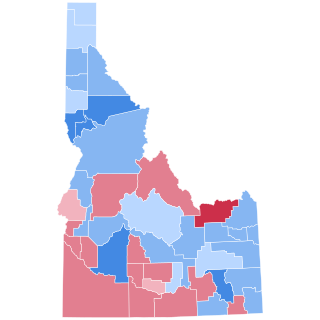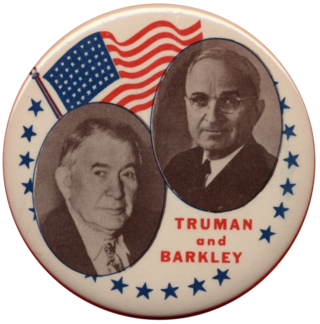
The 1944 United States presidential election was the 40th quadrennial presidential election. It was held on Tuesday, November 7, 1944. The election took place during World War II, which ended the following year. Incumbent Democratic President Franklin D. Roosevelt defeated Republican Thomas E. Dewey to win an unprecedented fourth term. It was also the fifth presidential election in which both major party candidates were registered in the same home state; the others have been in 1860, 1904, 1920, 1940, and 2016.

The 1948 United States presidential election was the 41st quadrennial presidential election. It was held on Tuesday, November 2, 1948. In one of the greatest election upsets in American history, incumbent Democratic President Harry S. Truman defeated heavily favored Republican New York Governor Thomas E. Dewey, and third-party candidates, becoming the third president to succeed the presidency upon his predecessor's death and be elected to a full term.

The 1952 United States presidential election was the 42nd quadrennial presidential election. It was held on Tuesday, November 4, 1952. Republican Dwight D. Eisenhower defeated Democratic Illinois Governor Adlai Stevenson II in a landslide victory, becoming the first Republican president in 20 years. This was the first election since 1928 without an incumbent president or incumbent vice president on the ballot.

The 1948 United States presidential election in New York took place on November 2, 1948. All contemporary 48 states were part of the 1948 United States presidential election. Voters chose 47 electors to the Electoral College, which selected the president and vice president.

The 1948 United States presidential election in Massachusetts took place on November 2, 1948, as part of the 1948 United States presidential election, which was held throughout all contemporary 48 states. Voters chose 16 representatives, or electors to the Electoral College, who voted for president and vice president.

The 1948 United States presidential election in Vermont took place on November 2, 1948, as part of the 1948 United States presidential election which was held throughout all contemporary 48 states. Voters chose three representatives, or electors to the Electoral College, who voted for president and vice president.

The 1948 United States presidential election in New Jersey took place on November 2, 1948. All contemporary 48 states were part of the 1948 United States presidential election. Voters chose 16 electors to the Electoral College, which selected the president and vice president.

The 1948 United States presidential election in New Hampshire took place on November 2, 1948, as part of the 1948 United States presidential election, which was held throughout all contemporary 48 states. Voters chose four representatives, or electors to the Electoral College, who voted for president and vice president.

The 1948 United States presidential election in Virginia took place on November 2, 1948, throughout the 48 contiguous states. Voters chose 11 representatives, or electors to the Electoral College, who voted for president and vice president.

This article lists those who were potential candidates for the Republican nomination for Vice President of the United States in the 1948 election. After New York Governor Thomas Dewey secured the Republican presidential nomination on the third ballot of the 1948 Republican National Convention, the convention needed to choose Dewey's running mate. Dewey and several party leaders discussed Dewey's running mate during the evening of June 24. House Majority Leader Charles A. Halleck and former Minnesota Governor Harold Stassen were both considered, but Dewey ultimately decided to ask California Governor Earl Warren to be his running mate. Warren had earlier said that he would not accept the vice presidential nomination, and asked for time to consider the offer. In the meantime, Stassen was offered the nomination if Warren declined. However, Dewey convinced the reluctant Warren to join his ticket. Halleck alleged that he had been promised the vice presidency in exchange for supporting Dewey, but Halleck's isolationism convinced Dewey and others to pass him over. The Dewey-Warren ticket was well-received by the press, as it combined the youthful, popular governors of two of the three most populous states in the nation. Despite being favored by most, the Dewey–Warren ticket lost the 1948 election to the Democratic Truman–Barkley ticket. In 1953, Warren was appointed Chief Justice of the United States by President Dwight D. Eisenhower.

The 1948 United States presidential election in Texas was held on November 2, 1948. Texas voters chose 23 electors to represent the state in the Electoral College, which chose the president and vice president.

The 1948 United States presidential election in Mississippi took place on November 2, 1948, in Mississippi as part of the wider United States presidential election of 1948.

The 1948 United States presidential election in Alabama was held on November 2, 1948. Alabama voters sent eleven electors to the Electoral College who voted for President and Vice-President. In Alabama, voters voted for electors individually instead of as a slate.

The 1948 United States presidential election in Idaho took place on November 2, 1948, as part of the 1948 United States presidential election. State voters chose four representatives, or electors, to the Electoral College, who voted for president and vice president.

The 1948 United States presidential election in North Carolina took place on November 2, 1948, as part of the 1948 United States presidential election. North Carolina voters chose 14 representatives, or electors, to the Electoral College, who voted for president and vice president.

The 1948 United States presidential election in Tennessee took place on November 2, 1948, as part of the 1948 United States presidential election. Tennessee voters chose 12 representatives, or electors, to the Electoral College, who voted for president and vice president.

The 1948 United States presidential election in Maryland took place on November 2, 1948, as part of the 1948 United States presidential election. State voters chose eight representatives, or electors, to the Electoral College, who voted for president and vice president.

The 1948 United States presidential election in Nebraska took place on November 2, 1948, as part of the 1948 United States presidential election. Voters chose six representatives, or electors, to the Electoral College, who voted for president and vice president.

In 1948, Harry S. Truman and Alben W. Barkley were elected president and vice president of the United States, defeating Republican nominees Thomas E. Dewey and Earl Warren. Truman, a Democrat and vice president under Franklin D. Roosevelt, had ascended to the presidency upon Roosevelt's death in 1945. He announced his candidacy for election on March 8, 1948. Unchallenged by any major nominee in the Democratic primaries, he won almost all of them easily; however, many Democrats like James Roosevelt opposed his candidacy and urged former Chief of Staff of the United States Army Dwight D. Eisenhower to run instead.
























